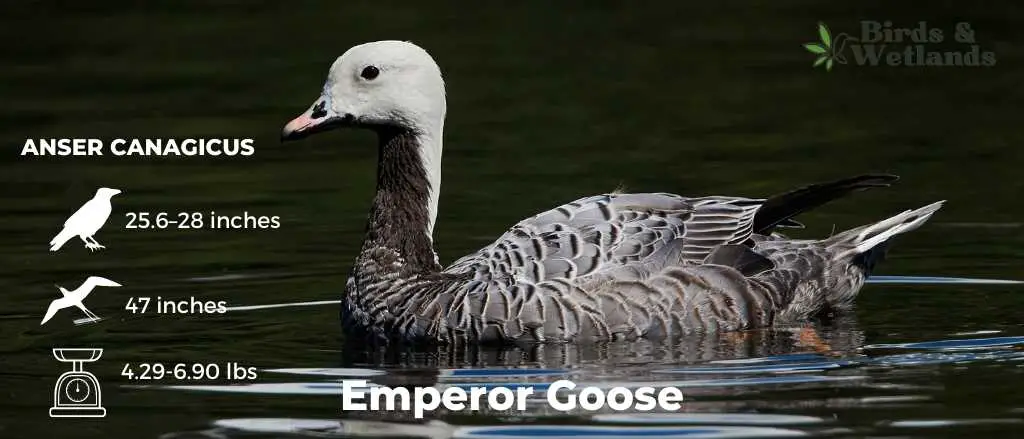This small, stocky goose can only be found in western Alaska and the Aleutian Islands, where it inhabits tidewater marshes, reefs, sheltered lagoons, and coastal tundra.
Emperor Goose
The Emperor Goose, also known as the beach goose or the painted goose, is one of the rarest geese in North America, and one that every birdwatcher hopes to see. This small and stocky goose is only found in Alaska. They have a wingspan of up to 4 feet and feed on the small plants in the mud at the edges of lakes and rivers, as well as roots and seeds.
Scientific Name: Anser canagicus
Height: 26–28 inches (66–71 cm) and females 25.6–27.5 inches (65–70 cm)
Wingspan: 119 centimetres (47 in)
Weight: Males – 2.766 kilograms (6.10 lb) and 3.129 kilograms (6.90 lb) / Females: 1.945 kilograms (4.29 lb)
Emperor Goose Description
The plumage is overall silvery gray, with a black and white margin making it look scaled. With a white head (which can become rust-colored in the summer months), it has a black throat and its bill is small and pink and has bright orange legs. The sexes are similar, but juveniles have duller plumage gray or blue-gray all over.
As with other tundra-dwelling birds, these geese get a deep rust stain from the iron in stagnant waterways, as they graze with their head and neck submerged, plucking vegetation out from the bottom. In addition, when the tide is out, they graze on the exposed mudflats.
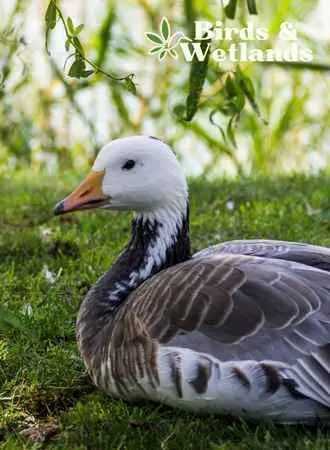
Listen to Emperor Goose
Emperor Goose Habitat & Range
They are migratory birds, which means they travel long distances to breed and then return to the same location in the winter. Emperor geese migrate from Alaska to Japan and the western Aleutian Islands in the Alaskan Peninsula or in places like Kodiak Island.
In the winter, emperor geese live in Alaska and winter in Alaska, Japan, and the western Aleutian Islands of the Alaska Peninsula. In the summer, they stay in Alaska.
Before going on to breeding grounds on the west coast of Alaska or wintering areas in the Aleutians, large flocks may stage for several weeks at a time in huge lagoons located on the north shore of the Alaska Peninsula throughout the spring and fall seasons.

Emperor Goose Range Map credit: allaboutbirds.org
Emperor Goose Diet
Emperor geese need large tracts of land with patchy vegetation, water, and ample food to survive. Emperor geese use their bills to catch fish (and occasionally small mammals) while swimming in the water or flying over it. They thrive in wetland habitats because they provide the birds with food and protection from predators such as bears and wolves.
Emperor geese are herbivores and their diet consists mostly of plants, seaweed, eelgrass, sea lettuce, algae, and grasses. They will also eat small invertebrates such as insects, mussels, barnacles, and snails.
In the winter months, when food is scarce, emperor geese have been known to eat small stones to help grind up the tough vegetation they are eating.
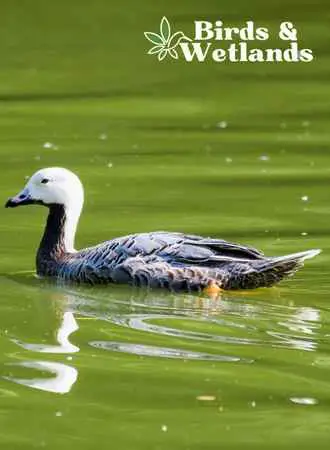
Emperor Goose Nesting
The breeding season is from late May to early June. The female emperor goose lays 3-8 eggs per season and the emperor geese nest is made from grasses and plant material. She does the majority of the incubation of the eggs, which take about 30 days to hatch.
The nest is a shallow dip in the ground, and the females choose a location among low foliage for increased visibility.
The male takes on a more active role in rearing his offspring after they’ve hatched—he helps keep predators away, insulates them against heat loss, and protects them from harm by sheltering them under his wings or body when necessary.
The young emperor goslings are precocial, meaning they are born with their eyes open and are able to walk and feed themselves shortly after birth. The parents will care for the young until they are old enough to fend for themselves, typically around 3-4 months of age.
In less than a day after hatching, young goslings are able to walk and swim, and they leave the nest site to follow their parents to favorable feeding places, which may be miles away from the nest.
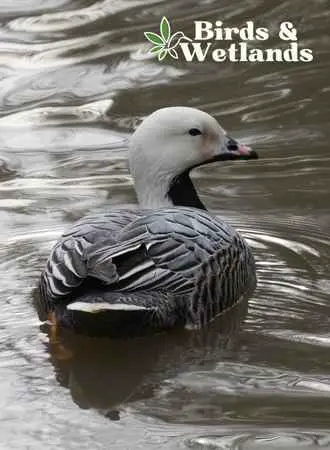
Life history
The average lifespan of an emperor goose is 10-12 years in the wild.
Found in Alaska in 2013, the oldest known Emperor Goose was a female that was at least 20 years and 3 months old.
Their name comes from their white crown and distinctive black throat, which can look like a royal cloak, hence the name emperor. They are often referred to as the beach goose or the painted goose, due to their beautiful plumage.

The emperor geese fly lower than many other arctic species, noticeably just above the ground, but they do go higher if they have sensed danger.
Mating Habits of Emperor Geese
Emperor geese are a monogamous species. They mate for life and both the male and female take part in raising their young. The mating season for emperor geese is typically from late May to early July.
During this time, the males will perform a ritual dance in order to attract the female emperor geese. Once paired up, the male and female will build a nest together and share incubation duties.
The Yukon-Kuskokwim Delta is home to the nesting grounds of around 90% of the world’s emperor geese breed.
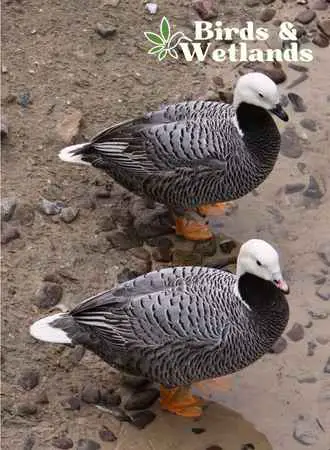
Emperor Geese Population
Unlike other arctic nesting geese and other goose species, the Emperor goose has a very slow growth rate, which has led to a declining population.
This goose species only breeds when three years old, and due to the harsh conditions in their breeding grounds, only 10% of goslings survive to adulthood, with even less surviving until age 3 to start breeding.
The worldwide population of Emperor geese is estimated to be in the region of 140,000 with 90% of these being based in Alaska, and most of the rest being found in Eastern Russia and is measured by the Y-K Delta Coastal Zone aerial survey.
Hunting Emperor Geese
Due to the slow growth, hunting of this bird is controlled by the Alaska migratory bird Council.
After the population came dangerously close to extinction in the 1980s and was consequently made off-limits to hunters, the emperor goose population began to slowly recover and was eventually made available for subsistence hunting during the spring and summer months of 2017 and general hunting during the fall and winter months of 2017.
In 2016, the numbers increased which allowed some hunting for the first time since the 70s so both the spring/summer and fall/winter seasons for harvesting imperial geese were made available in 2017 for subsistence hunting and have continued to be available, though this is reviewed each year. The limit is one bird per hunter.
Conservation
Due to their slow population growth and their reliance on the harsh Alaskan Western coast, they are vulnerable to subsistence hunting, oil pollution, and climate change.
The Alaska department is thus far preferring an educational approach to helping the species rather than a hunting ban.
Key points
•The Emperor Goose is a small, stocky goose that can only be found in western Alaska and the Aleutian Islands.
• They have a wingspan of up to 4 feet and feed on the small plants in the mud at the edges of lakes and rivers, as well as roots and seeds.
• Emperor geese are migratory birds, which means they travel long distances to breed and then return to the same location in the winter.
• The breeding season is from late May to early June, during which time the male will perform a ritual dance in order to attract a mate.
• Both parents take part in raising their young until they are old enough to fend for themselves (around 3-4 months).
• Due to their slow population growth rate, hunting of this bird is controlled by law.

